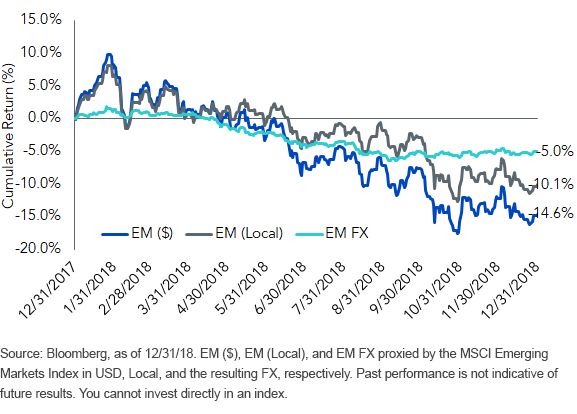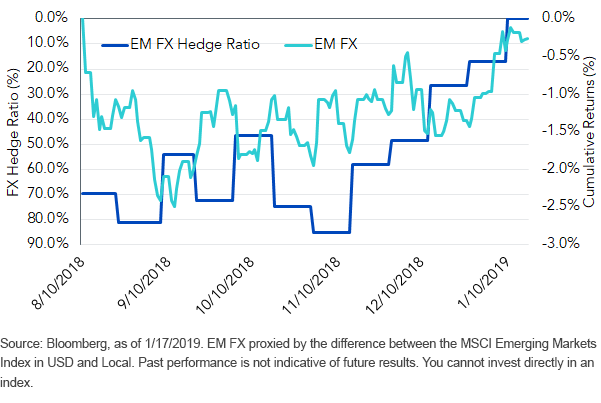Solving The Challenge Of EM FX
In 2018, emerging market (EM) equities ended the year down nearly 15%. Approximately one-third of that loss was attributable to broad-based dollar strength against most EM currencies. Heading into 2019, we question whether investors should remain agnostic to managing EM foreign exchange (FX) risk.
Thinking in Bets
Anytime investors consider allocating internationally, they’re making two decisions: views on asset returns and views on currency returns. The more understood (and fretted-over) decision is whether or not the foreign asset will go up or down. However, the second decision has unfortunately been on autopilot for many U.S. investors. Due to benchmark decisions, a majority of investors default to the view that anytime they invest internationally, the value of the U.S. dollar will need to go down for them to capture local asset returns.
2018 EM Performance
After an amazing 2017, emerging markets faced headwinds over trade disputes, tighter central bank policies and concerns about the state of the global economy. In general, these risky assets underperformed. For investors that benchmark to the MSCI Emerging Markets Index, EM equities declined over 10%. Declines were 5% in the U.S., 7% in Europe and 15% in Japan. While no one was satisfied with last year’s peformance, we believe we’ve identified a solution for managing currency risk in EM portfolios.
EM Equity Returns, 12/31/17–12/31/18

Currency as a Factor
While most active managers have sought to focus on the value they can add via local asset returns, our research has found that adding value via currency decisions is just as important. In the WisdomTree Emerging Markets Multifactor Fund (EMMF), our active approach to factor investing is applied to both stock selection and currency selection. While equity selection focuses on value, quality, momentum and low correlation, the decision on currency hedging is determined by momentum. For example, if a specific EM currency is trending toward depreciation, an investor should hedge. While the trend in FX eventually will have an impact on the companies in that market, the investor feels these impacts much more immediately.
EMMF Currency Positioning
Markets are, by definition, dynamic. This is also the reason why we seek to adjust our FX hedges multiple times per month based on our model. In the chart below, we show EMMF’s FX positioning over time. As downside EM FX momentum began to stall, our dynamic approach to FX risk gradually reduced our hedges. In the second week of January, EMMF was currently 100% long EM FX.
EMMF Currency Hedging, 8/10/18–1/17/19

While active management has generally focused on security selection, we believe investors should continue to probe the decisions managers are making regarding FX risk. Through our dynamic approach, we believe we’ve identified a way to add value that helps solve the challenge that currency risk plays in emerging market portfolios.
Unless otherwise stated, all data is from Bloomberg as of December 31, 2018.
Disclaimer: Investors should carefully consider the investment objectives, risks, charges and expenses of the Funds before investing. U.S. investors only: To obtain a prospectus containing this ...
more


